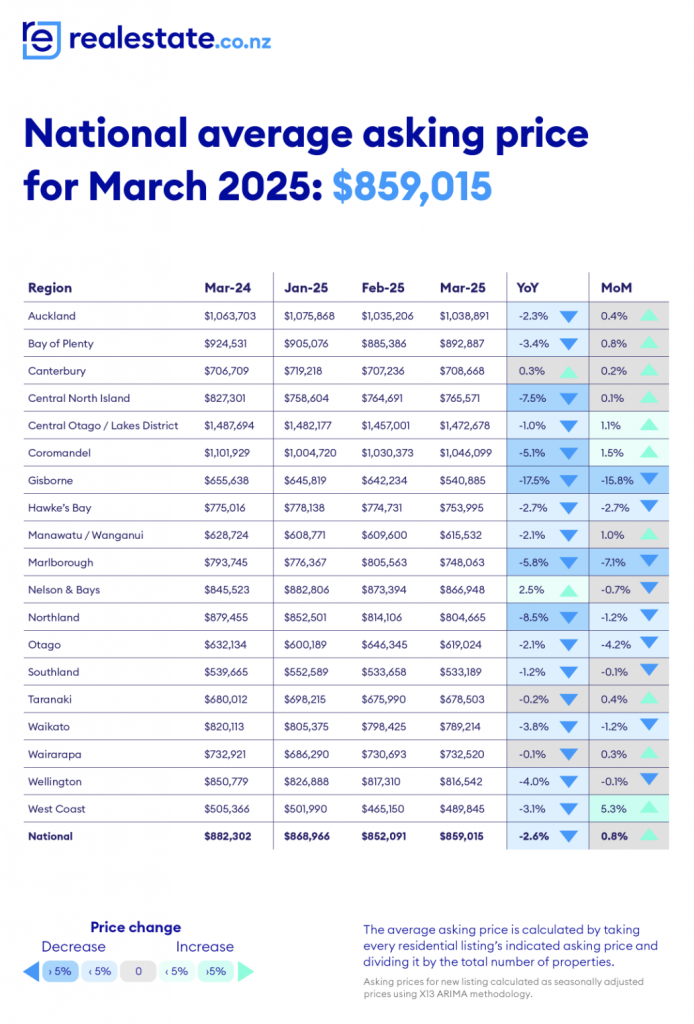Property Market Shows Signs of Recovery Amid Economic Caution
The property market is beginning to show signs of life, even as economic uncertainty lingers. While asking prices remain stable and stock levels continue to climb, buyers are still proceeding with caution.
@realty recorded another successful month, selling $526,985,544 worth of property across the region—marking a 30.67% increase from last year’s sales.
Key Takeaways:
- Modest Price Declines: Average asking prices dipped slightly across most regions, with the national average staying below $900,000 for over two years.
- Stock at Decade-High Levels: 36,870 properties were on the market in March 2025, marking a 10.9% increase year-on-year.
- Faster Sales: Properties spent less time on the market in March compared to February, suggesting a gradual pickup in buyer activity.
Market Overview: Signs of Momentum
Despite growing economic optimism, data from realestate.co.nz indicates the property market is still in recovery mode. March saw an increase in new listings both month-on-month and year-on-year, while total stock rose in nearly every region, signaling renewed seller confidence.
Buyers remain cautious, but sales volumes are on the rise. REINZ data for February recorded 6,287 properties sold nationwide—a 3.4% increase compared to the same month in 2024. Though no dramatic market surge has occurred, momentum is gradually building as 2025 progresses.

Stable Prices Suggest Buyer Caution
The national average asking price edged up by 0.8% month-on-month in March but remains 2.6% lower than in March 2024. This stability indicates that buyers are still holding back, despite increased stock and economic improvements.
- Long-Term Price Trends: The national average has remained below $900,000 since December 2022, when it last peaked at $916,487. In January 2022, prices hit a market high of $983,415.
- Regional Variations: Nelson & Bays was the only region to record year-on-year price growth (up 2.5% to $866,948). Month-on-month, Coromandel (1.5%), Central Otago/Lakes District (1.1%), and the West Coast (5.3%) saw modest gains.
- Wider Market Trends: Six regions, including Gisborne, Hawke’s Bay, Marlborough, Northland, Otago, and Waikato, experienced both month-on-month and year-on-year declines, reflecting continued market hesitancy.
With stock levels remaining high, price pressures are unlikely to increase significantly in the short term.
Stock Levels Continue to Climb
March saw 36,870 properties on the market, representing a 10.9% year-on-year increase. Stock levels rose in all regions except Northland, where they dipped by just 0.4%.
- More Sellers Enter the Market: Two years ago, high interest rates and election uncertainty led many sellers to hold off listing. Now, conditions have shifted, with 7,586 more properties for sale compared to March 2023.
- Faster Sales: In February, many listings had been on the market for 60 to 90 days. By March, a larger proportion were listed for just 30 to 60 days, indicating quicker sales.

New Listings Reflect Growing Seller Confidence
Vendors were active in March, with 12,029 new listings—up 5.0% year-on-year. Thirteen of the 19 regions saw an increase in new listings, reinforcing the trend of rising seller confidence.
- Largest Growth: Gisborne led the country for the second consecutive month, with a 23.8% jump in new listings year-on-year.
- Largest Decline: Coromandel recorded the sharpest drop, with new listings down 28.8%.
Conclusion: A Market in Transition
New Zealand’s property market is showing quiet momentum. While price growth remains subdued, increasing stock levels and faster sales indicate renewed activity. However, with regional variations still significant, local expertise remains invaluable for buyers and sellers navigating this evolving landscape.
Let us help!
If you’re considering buying or selling a property and seeking to understand the current market conditions, why not chat with one of our friendly agents to understand how we can help?
Or feel free to click here to get your instant property estimate.
